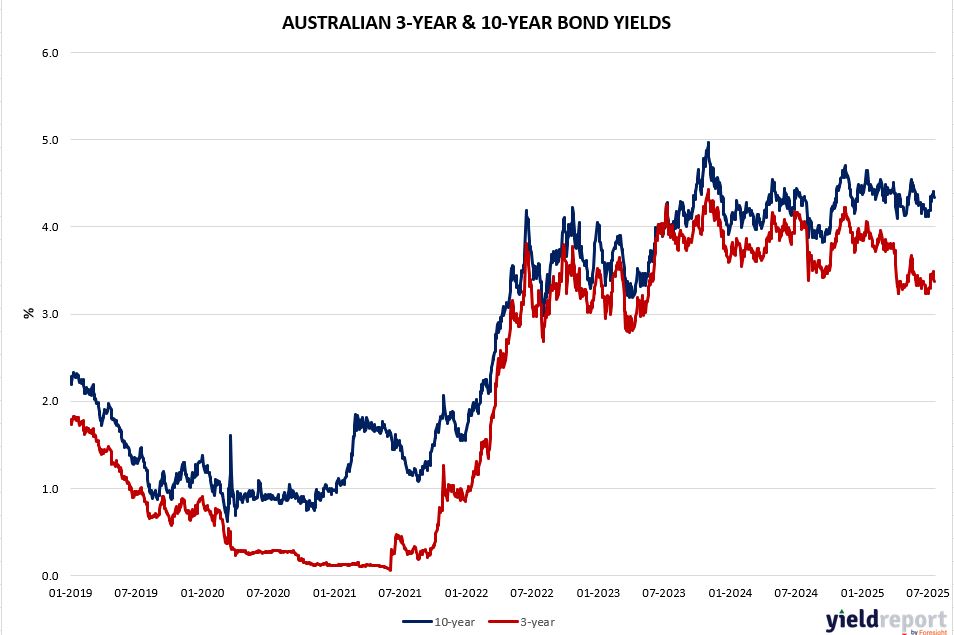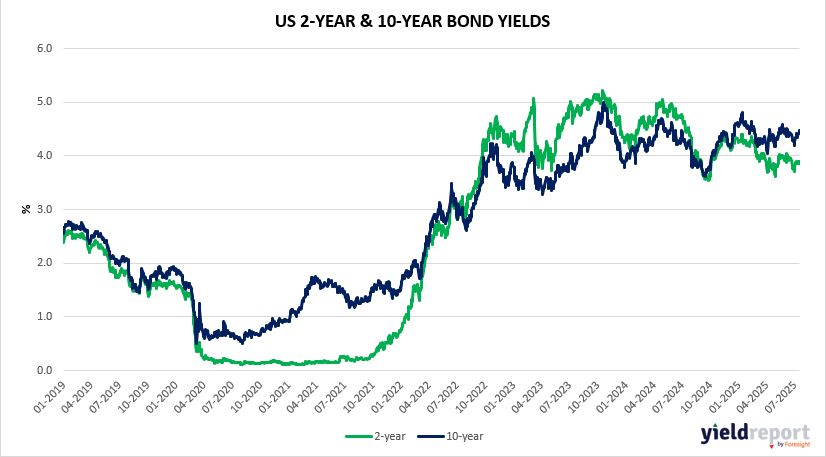| Close | Previous Close | Change | |
|---|---|---|---|
| Australian 3-year bond (%) | 3.37 | 3.37 | 0 |
| Australian 10-year bond (%) | 4.332 | 4.338 | -0.006 |
| Australian 30-year bond (%) | 5.025 | 5.019 | 0.006 |
| United States 2-year bond (%) | 3.85 | 3.875 | -0.025 |
| United States 10-year bond (%) | 4.376 | 4.431 | -0.055 |
| United States 30-year bond (%) | 4.944 | 4.999 | -0.055 |
Overview of the Australian Bond Market
Australian government bond yields dipped slightly on Monday, July 21, 2025, with the 10-year yield falling 4 basis points to 4.30%, reflecting cautious sentiment ahead of key data releases. The 2-year yield eased 1 basis point to 3.31%, while the 15-year yield dropped 3 basis points to 4.65%, signaling a modest flattening of the yield curve.
The recent soft employment data, with unemployment at 4.3% and only 2,000 jobs added, continues to support an 85-basis point rate cut expectation over the next year, targeting 3.02% by mid-2026, with an August cut to 3.68% priced at 94%. Tomorrow’s composite leading index and PMI flash data will provide fresh insights. The AUD’s 0.08% rise to 0.6512 reflects trade optimism from Albanese’s China visit, though global yields remain muted pending US data, including existing home sales tonight at midnight AEST.

Overview of the US Bond Market
Gains in Treasuries were led by longer maturities, with the 30-year yield down four basis points to 4.95%. The dollar slid against all of its developed-world peers. The yen climbed as Japan’s Prime Minister Shigeru Ishiba said he would carry on as leader even as the ruling coalition lost its majority in the upper house election.
Treasury prices gained, pushing down the yield on 10-year notes to 4.37%, from 4.432% Friday. Investors are anticipating that the Federal Reserve will cut short-term interest rates by the fall, with futures markets showing a 58% chance of at least a quarter-point rate cut by the Fed’s September meeting, according to CME Group.
Investors also kept a close eye on tariff headlines. President Donald Trump may issue more unilateral tariff letters before Aug. 1, White House Press Secretary Karoline Leavitt said. More trade deals may also be reached before the deadline, she added.
The potential ouster of Federal Reserve Chair Jerome Powell by President Donald Trump would drive the 30-year Treasury yield higher by more than half a percentage point, according to Deutsche Bank AG strategists.
On July 16, when headlines flashed across the wire that Trump was likely to fire Powell — a claim that Trump denied within an hour — US equities, the dollar and long-term US government bonds retreated sharply while short-term Treasuries rallied.
Based on the gyrations in Treasuries across the curve seen during that brief time period last week, the 30-year nominal Treasury yield could surge some 56 basis points, the Deutsche Bank strategists wrote — even as the front-end of the Treasury curve rallies on expectations of easier monetary policy in the short-term.
Meanwhile, Japanese government bonds are vulnerable to further selling when trading resumes Tuesday following a historic election defeat for Prime Minister Shigeru Ishiba.
Yields on longer-maturity JGBs of 20 to 40 years dipped slightly on Friday but have been in an acute uptrend over recent months. The moves in Japanese yields, which have flowed through into global markets, reflect concerns among investors that the government is spending beyond its means.
While Ishiba hanging on as leader for now provides a measure of continuity for markets, he will also need to find ways to placate opposition lawmakers seeking tax cuts and households wanting relief from inflation. Any concessions to these pressures can be expected to quickly translate into higher bond yields.
Japanese Prime Minister Shigeru Ishiba sought to buy time in office following a second election setback in less than a year. But whether he stays days, weeks or even months, Sunday’s vote made clear that his Liberal Democratic Party needs an overhaul to stay relevant.
Ishiba on Monday vowed to remain in his job even though his LDP-led coalition finished Sunday running a government without a majority in both chambers of parliament for the first time since the party’s founding seven decades ago. While it has ruled Japan for most of that period, younger voters are increasingly turning toward populist smaller parties as rising prices fuel discontent.


